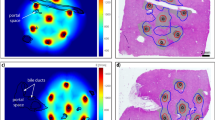Abstract
Radiofrequency ablation has emerged as a minimally invasive option for liver cancer treatment, but local tumor recurrence is common. To eliminate residual tumor cells in the ablated tumor, biodegradable polymer millirods have been designed for local drug (e.g., doxorubicin) delivery. A limitation of this method has been the extent of drug penetration into the tumor (<5 mm), especially in the peripheral tumor rim where thermal ablation is less effective. To provide drug concentration above the therapeutic level as needed throughout a large tumor, implant strategies with multiple millirods were devised using a computational model. This dynamic, 3-D mass balance model of drug distribution in tissue was used to simulate the consequences of various numbers of implants in different locations. Experimental testing of model predictions was performed in a rabbit VX2 carcinoma model. This study demonstrates the value of multiple implants to provide therapeutic drug levels in large ablated tumors.






Similar content being viewed by others
References
Barnett CC Jr, Curley SA (2001) Ablative techniques for hepatocellular carcinoma. Semin Oncol 28:487–496
Berber E, Siperstein AE (2007) Perioperative outcome after laparoscopic radiofrequency ablation of liver tumors: an analysis of 521 cases. Surg Endosc 21:613–618
Bertazzoli C, Chieli T, Grandi M et al (1970) Adriamycin: toxicity data. Experientia 26:389–390
Curley SA, Marra P, Beaty K et al (2004) Early and late complications after radiofrequency ablation of malignant liver tumors in 608 patients. Ann Surg 239:450–458
Fung LK, Shin M, Tyler B et al (1996) Chemotherapeutic drugs released from polymers: distribution of 1, 3-bis(2-chloroethyl)-1-nitrosourea in the rat brain. Pharm Res 13:671–682
Gannon CJ, Curley SA (2005) The role of focal liver ablation in the treatment of unresectable primary and secondary malignant liver tumors. Semin Radiat Oncol 15:265–272
Goldberg SN (2001) Radiofrequency tumor ablation: principles and techniques. Eur J Ultrasound 13:129–147
Grimm P, Sylvester J (2004) Advances in brachytherapy. Rev Urol 6:S37–S48
Guerin C, Olivi A, Weingart JD et al (2004) Recent advances in brain tumor therapy: local intracerebral drug delivery by polymers. Invest New Drugs 22:27–37
Harrison LE, Koneru B, Baramipour P et al (2003) Locoregional recurrences are frequent after radiofrequency ablation for hepatocellular carcinoma. J Am Coll Surg 197:759–764
Johnson PC, Saidel GM (2002) Thermal model for fast simulation during magnetic resonance imaging guidance of radio frequency tumor ablation. Ann Biomed Eng 30:1152–1161
Kaplan ID, Meskell P, Oldenburg NE et al (2006) Real-time computed tomography dosimetry during ultrasound-guided brachytherapy for prostate cancer. Brachytherapy 5:147–151
Laginha KM, Verwoert S, Charrois GJ et al (2005) Determination of doxorubicin levels in whole tumor and tumor nuclei in murine breast cancer tumors. Clin Cancer Res 11:6944–6949
Lessard E, Kwa SL, Pickett B et al (2006) Class solution for inversely planned permanent prostate implants to mimic an experienced dosimetrist. Med Phys 33:2773–2782
Menei P, Jadaud E, Faisant N et al (2004) Stereotaxic implantation of 5-fluorouracil-releasing microspheres in malignant glioma. Cancer 100:405–410
Menei P, Capelle L, Guyotat J et al (2005) Local and sustained delivery of 5-fluorouracil from biodegradable microspheres for the radiosensitization of malignant glioma: a randomized phase II trial. Neurosurgery 56:242–248 discussion 242–248
Ortiz R, Au JL, Lu Z et al (2007) Biodegradable intraprostatic doxorubicin implants. AAPS J 9:E241–E250
Qian F, Szymanski A, Gao J (2001) Fabrication and characterization of controlled release poly(D,L-lactide-co-glycolide) millirods. J Biomed Mater Res 55:512–522
Qian F, Stowe N, Liu EH et al (2003) Quantification of in vivo doxorubicin transport from PLGA millirods in thermoablated rat livers. J Control Release 91:157–166
Qian F, Stowe N, Saidel GM et al (2004) Comparison of doxorubicin concentration profiles in radiofrequency-ablated rat livers from sustained- and dual-release PLGA millirods. Pharm Res 21:394–399
Ridge JA, Collin C, Bading JR et al (1988) Increased adriamycin levels in hepatic implants of rabbit Vx-2 carcinoma from regional infusion. Cancer Res 48:4584–4587
Swistel AJ, Bading JR, Raaf JH (1984) Intraarterial versus intravenous adriamycin in the rabbit Vx-2 tumor system. Cancer 53:1397–1404
Szymanski-Exner A, Gallacher A, Stowe NT et al (2003) Local carboplatin delivery and tissue distribution in livers after radiofrequency ablation. J Biomed Mat Res 67A:510–516
Tanabe KK, Curley SA, Dodd GD et al (2004) Radiofrequency ablation: the experts weigh in. Cancer 100:641–650
Tateishi R, Shiina S, Teratani T et al (2005) Percutaneous radiofrequency ablation for hepatocellular carcinoma. An analysis of 1000 cases. Cancer 103:1201–1209
Ueno S, Tanabe G, Sako K et al (2001) Discrimination value of the new western prognostic system (CLIP score) for hepatocellular carcinoma in 662 Japanese patients. Cancer of the Liver Italian Program. Hepatology 34:529–534
Wallace KB (2003) Doxorubicin-induced cardiac mitochondrionopathy. Pharmacol Toxicol 93:105–115
Weinberg BD, Ai H, Blanco E et al (2007) Antitumor efficacy and local distribution of doxorubicin via intratumoral delivery from polymer millirods. J Biomed Mater Res A 81:161–170
Weinberg BD, Blanco E, Lempka SF et al (2007) Combined radiofrequency ablation and doxorubicin-eluting polymer implants for liver cancer treatment. J Biomed Mater Res A 81:205–213
Weinberg BD, Patel RB, Exner AA et al (2007) Modeling doxorubicin transport to improve intratumoral drug delivery to RF ablated tumors. J Control Release 124:11–19
Yamada Y, Bhatia S, Zaider M et al (2006) Favorable clinical outcomes of three-dimensional computer-optimized high-dose-rate prostate brachytherapy in the management of localized prostate cancer. Brachytherapy 5:157–164
Acknowledgments
This work was supported by NIH grant R01 CA90696 to JG. BW and RP are supported in part by the NIH grant T32 GM07250 to the Case Western Reserve University Medical Scientist Training Program. BW is also supported by DOD predoctoral fellowship BC043453. This is manuscript CSCN P012 from the ‘Cell Stress and Cancer Nanomedicine’ program in the Simmons Comprehensive Cancer Center at the University of Texas Southwestern Medical Center at Dallas.
Author information
Authors and Affiliations
Corresponding author
Rights and permissions
About this article
Cite this article
Weinberg, B.D., Patel, R.B., Wu, H. et al. Model simulation and experimental validation of intratumoral chemotherapy using multiple polymer implants. Med Biol Eng Comput 46, 1039–1049 (2008). https://doi.org/10.1007/s11517-008-0354-7
Received:
Accepted:
Published:
Issue Date:
DOI: https://doi.org/10.1007/s11517-008-0354-7




